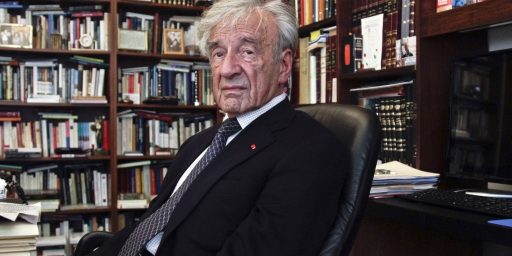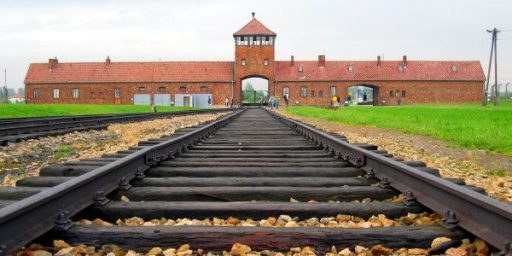Last Schindler’s List Survivor Dies At 83
The last person to be saved by Oskar Schindler’s famous list during the Holocaust died recently in Los Angeles:
Among the 1,100 Jews saved from the Nazis by German industrialist Oskar Schindler was an emaciated 13-year-old boy named Leon Leyson, who had to stand on a box to reach the machinery in the Krakow factory where Schindler sheltered him and his family.
The boy Schindler called “Little Leyson” survived the Holocaust to start life over in Los Angeles. He taught high school in Huntington Park for 39 years, rarely mentioning to anyone the pain and perils he experienced during the war that claimed the lives of 6 million Jews.
Then came the celebrated 1993 movie “Schindler’s List,” which ignited public interest in the stories of Holocaust survivors. Coaxed into breaking five decades of near-silence on the subject, Leyson — the youngest member of the group rescued by Schindler — embarked on a public speaking career that took him across the United States and Canada to share his story about coming of age during the Nazis’ brutal reign.
“Any time he told his story he never used notes, he never gave the same talk twice. It always came from the head and the heart,” said his friend and Chapman University religious studies professor Marilyn Harran. “It made people walk away wanting to be better people, to care more, to remember not only the Holocaust but to remember that we can never be indifferent.”
(…)
he youngest of five children of a glass factory worker and his wife, Leyson was born Sept. 15, 1929, in Narewka, Poland, a village near the Russian border. He later moved to Krakow with his family.
He was a few weeks shy of his 10th birthday in 1939 when German forces invaded Poland and life as he had known it began to crumble.
Six months after the invasion, Poland’s Jews were ordered into a section of Krakow enclosed by a fence, the tops of which, Leyson often recalled, resembled grave markers. “I don’t think that was an accident,” he told the Los Angeles Times in 1994. His parents loaded their belongings onto a wagon and were crammed into one bedroom of an apartment in the Jewish ghetto with only a sheet separating them from another family.
Random shootings of Jews escalated into mass killings and deportations to extermination camps. The two constants in his life became hunger and fear.
One time when SS commandos surrounded the ghetto, he and a few other boys hid in the attic crawl space of a building next to their apartment. His mother, Anna, and another boy’s mother remained outside. But when the sound of gunshots and mayhem grew louder, Leyson’s mother scrambled into the cramped hideaway and with the boys watched in horror as the commandos took the other mother away.
“I can recount dozens of times where if I had stepped … to my left I would have been gone, or if I happened to step to my right,” Leyson told The Times. “It wasn’t anything like being smart or clever or anything like that.”
Two of his brothers also were killed. Older brother Hershel had fled to the family’s village and died in a massacre of its 500 residents.
Another brother, Tsalig, was taken from the ghetto and placed on a train to a concentration camp. In “Schindler’s List,” the Steven Spielberg movie based on the book by Thomas Keneally, Schindler is shown getting on the train to save his accountant. He recognized Leyson’s brother and tried to save him, but the 16-year-old refused to budge because he was with his girlfriend, who was not on Schindler’s list of employees.
“Leon could never make it through this painful part of his talk without breaking down,” but didn’t stop there because of “his determination and tenacity to keep telling the story,” said William Elperin, president of the 1939 Club, an organization of Holocaust survivors and descendants.
After seeing the movie at a screening, Leyson was awed, particularly by scenes showing boys running from the Nazi commandos. “It was like having an out-of-body experience,” he told The Times, “because those little kids who were … trying to get away from the Sondercommando — that was me. That was my friends.”
His only criticism was that he felt the film emphasized the imperfections in Schindler’s character — the womanizing, profiteering and Nazi ties — and did not show enough of the businessman’s “basic human decency.” Leyson worked 12-hour shifts like the adult Jews, but Schindler doubled his rations when he saw how weak he was and took him off the line when his eyesight began to falter. He left packs of cigarettes for Leyson’s father and added Leyson’s mother and surviving siblings to his list, making them one of the few families he took under wing.
“He put everything on the line,” Leyson said of Schindler in the Fort Collins Coloradan in 2010. “Even to treat us as human being was against the law…. He did it because he was a decent human being.”
It’s just too bad there weren’t more people like him at that time and in that place.





From the LAT:
As the Talmud teaches: “”Whoever destroys a soul, it is considered as if he destroyed an entire world. And whoever saves a life, it is considered as if he saved an entire world.”
When I was a kid, We had a family move into the house across the street. The mother and father were two of the sweetest kindest people in the world, very soft-spoken but never a harsh word, not even about the anti-semite who lived next door to them. I never asked, they never volunteered, but no mattered how hard I tried, my eyes inevitably found their way to the tattoos.
The Righteous Among The Nations:
I disagree with that last line. If ordinary people had that moral clarity and courage this would be a very different world.